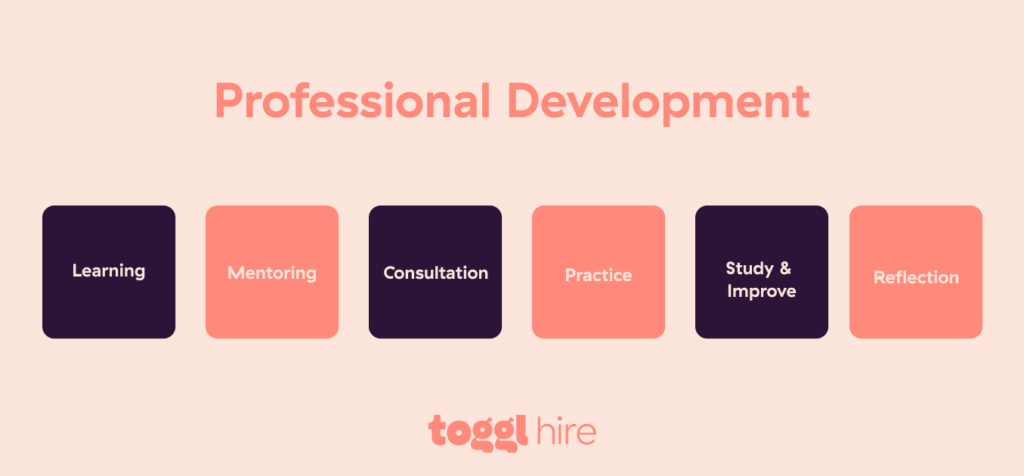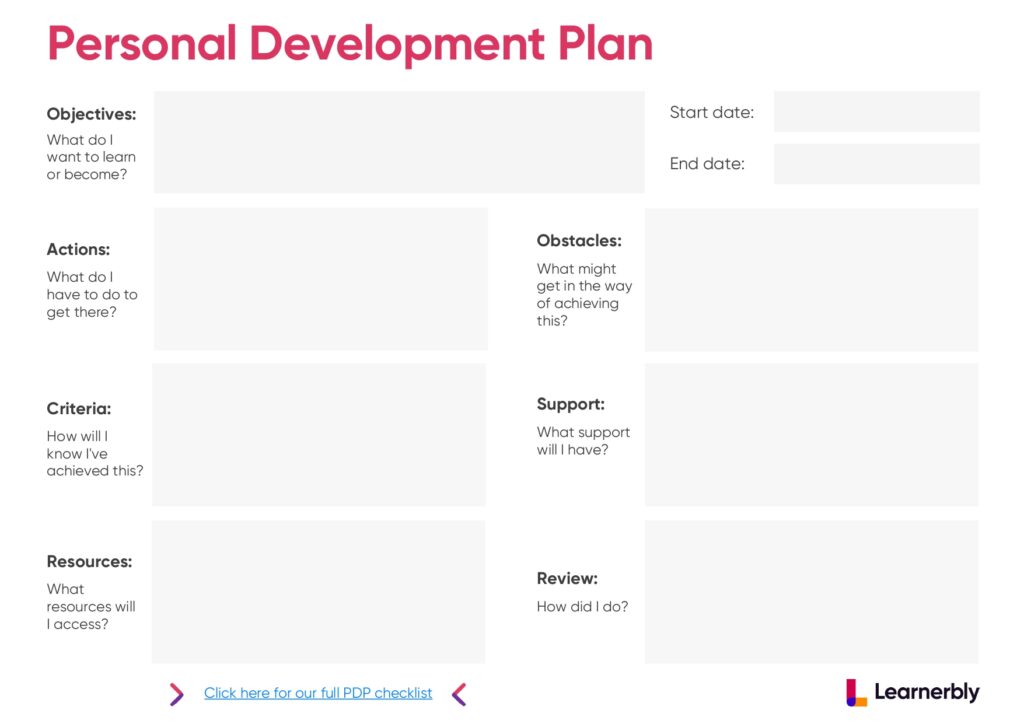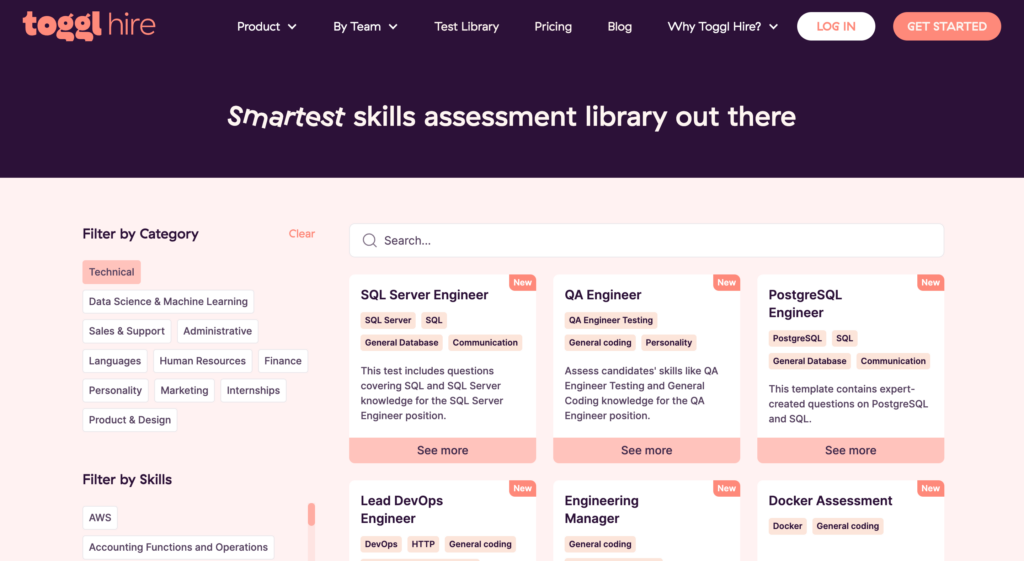Rome wasn’t built in a day and no CEO became a CEO overnight. All good career paths consist of gradual steps, lots of learning and hard work.
And if you don’t want to take chances with your employees’ career paths, you need a solid professional development plan.
In this piece, we’re giving you 7 practical steps for writing one, as well as examples of a professional development plan for any industry and role.
TL;DR – Key Takeaways
A professional development plan is a dynamic, changing document, describing an employee’s skill set and career goals, and aspirations.
These development plans have many benefits for companies: better performance, engagement, retention, company reputation, and more. You also get lower skills shortages and better succession planning.
There are 7 steps to creating a good professional development plan: understanding your team’s key career goals and objectives, doing a skills assessment test, and setting development goals. This is followed by creating an action plan, setting a timeline, planning regular reviews, and documenting the plan.
What is a professional development plan?
A professional development plan is a document outlining an employee’s current skill set, goals for the future, and potential strategies to achieve those realistic goals.
Professional development plans are dynamic, ever-changing documents. They are unique and written for each individual employee, reflecting their skills and career goals.
Great professional development plans change over time as employees develop new skills and go through continuing education to reach their career goals.
| Section | Description | Example |
|---|---|---|
| Employee Information | Basic details about the employee. | Name: John Doe Position: Marketing Associate Department: Marketing |
| Career Objectives | The employee’s long-term and short-term career goals. | Long-term goal: Become a Marketing Manager within 5 years. Short-term goal: Gain expertise in digital marketing strategies and analytics. |
| Skills Assessment | The employee’s current skills and areas for improvement. | Current skills: Content creation, basic SEO knowledge, event planning. Areas for improvement: Digital marketing strategies, data analytics, and leadership skills. |
| Development Goals | Specific skills or knowledge the employee aims to acquire or improve. | 1. Gain advanced knowledge in digital marketing strategies. 2. Learn how to use data analytics tools to measure marketing performance. 3. Develop leadership skills. |
| Action Plan | Specific actions the employee will take to achieve their development goals. | 1. Enroll in a digital marketing certification course. 2. Attend a workshop on data analytics tools. 3. Participate in the company’s leadership development program. |
| Timeline | The timeframe for achieving each development goal. | 1. Complete the digital marketing course within the next 6 months. 2. Attend the data analytics workshop by the end of Q3. 3. Complete the leadership development program within the next year. |
| Progress Review | Regular review dates to assess progress and make necessary adjustments. | Review progress with the manager every quarter. Adjust the plan as necessary based on feedback and progress. |
Why should companies consider introducing professional development programs?
It can sound like a lot of work for your HR team, so why would you consider creating one for your team members? Here are a few good reasons.
Better employee performance.
Think of it this way: employees who know what they need to do to get to that next step on the ladder – will do just that. They’ll perform better with a custom-tailored professional growth plan because they have clearer expectations.
Improve employee engagement and retention.
Employees who know what to strive for are more engaged in the workplace and have higher job satisfaction. They are more likely to perform better and stay with you longer instead of seeking out new career opportunities. Of course, this is as long as you fulfil your promises around career growth.
Better company reputation and an easier way to attract new talent.
A company offering professional development opportunities stands out in the hiring market. Potential new hires know that the company is willing to invest in the high-quality professional development of their people, which leads to better applicants and more applications.
A reduced skills gap and no skills shortage.
Instead of hiring all over again every time you need new skills, you can invest in professional development programs and allow your existing employees to fill that gap themselves.
Better succession planning.
You’ll no longer face uncertainties when someone retires or takes a role in a different company. A professional development plan encompasses succession planning for each role. With this plan, you’ll know exactly who grows into what role and what kind of new skills they acquire over time.
Better company performance.
With a professional development plan in place, your company will be more adaptable to new challenges. You’ll have an easier time innovating and developing new ideas too. Last but not least, your customer service is bound to improve.
Step-by-step tutorial on how to create a Professional Development Plan for your team
A good professional development plan requires thoughtful planning and preparation.
It’s also completely different for each role, individual and their personal goals. Here is a step-by-step guide to creating a professional development plan for any role.

Step 1: Understand your team members’ career objectives
Every good professional development plan is catered to an individual. This means you have to talk to them and understand their needs and professional development plans for the future.
You want to learn what they want to achieve with their career, in the short and long term. It is absolutely necessary to do this step first.
For example, you just hired a new marketing manager for your team. Here are some long-term and short-term goals and objectives that they could have.
Short-term career objective: get more familiar with on-page SEO, especially running website audits. Within 6 months, get more familiar with technical SEO, sitemaps, page loading speed, and influencing factors.
This is a pretty specific, time-bound goal that is achievable and relevant. This professional development goal can be achieved with internal training sessions (if you have the right person on the team) and professional development courses.
Long-term career objective: improve leadership, soft, and managerial skills to build the career path and become a chief marketing officer or VP of marketing within 3-4 years. Keeping up with industry trends and achieving professional success by continuously crushing all KPIs and metrics for their current role.
Once again, this is a goal that is at the same time both specific and broad enough. For you, as the employer, it tells you what job-specific knowledge this person might need help with. More importantly, it shows you the employee’s professional interests in career advancement and how likely they are to stay with you.
Step 2: Do a skills assessment
Before creating a professional development plan for the future, determine where your employees stand at the moment. To find relevant professional development opportunities for them, as well as determine how realistic their goals are, it is useful to test their existing skills first.
The great news is that there is no shortage of skills assessment tools on the market. Apps such as Toggl Hire allow you to test hard and soft skills for various roles.
To create a good professional development plan, test your employees for the skills relevant to their existing roles. Then, test them against their professional development goals. In other words, our marketing manager, from the example above, could get a skills test with questions for a CMO or VP of marketing.
This will show you if they are already on track to reach their career goals or if they require professional development training and some help along the way.
Self-assessment is a good idea in theory, but relying on an independent tool such as Toggl Hire is better.
Step 3: Set development goals
Professional development goals are necessary if you want your employees to come through with their plans. If a marketing manager wants to become a chief marketing officer, it usually does not happen overnight. Instead, it involves milestones and smaller goals to take this person from point A to point B.
For this specific example, professional development goals could be:
Continuing professional education in the field of marketing
Successfully hiring and onboarding a new member of the marketing team
Participating in training programs in the field of SEO, PPC and social media marketing
And others

Make them specific and actionable, and most importantly, ensure those professional development goals are measured and tracked.
Step 4: Create an action plan
This is arguably the most difficult part of the professional development plan. As the hiring manager (or just manager), you need to map out concrete steps employees should take to go from point A to point B.
For example:
Completing an online course in SEO
Putting together a job ad and an ideal candidate profile for a new marketing hire
Creating a structured interview and evaluation process for new hires
Creating an onboarding process for new marketing hires
Enrolling in different mentoring programs to partner up with senior marketers
Note that the employee should do the heavy lifting here. The HR/management do not know all the possible professional development opportunities that they could pursue. This is why it’s crucial that the plan is written in collaboration and that it all starts with a conversation between the employee and the HR team or a manager.

Step 5: Set a timeline
Great things don’t happen overnight. And if you don’t set specific dates for your employees’ goals, they may not happen at all. The best plans are time-bound, ensuring everyone involved sticks to them.
In the case of professional development plans, it’s beneficial for both parties.
One, the employees know that they can expect a promotion/salary increase/lateral move after a certain milestone is hit. On the other hand, the employer knows that they can expect certain results after a specific period of time.
For example:
Month 1: completed a course in SEO
Month 3: acquired a certification in technical SEO
Month 6: successfully hired a new marketing assistant for your team
Year 1: successfully trained and onboarded the new hire
Step 6: Plan for regular reviews
The time between the different stages of a professional development plan can take weeks and sometimes months. During that time, employees’ priorities may change, their job satisfaction decrease, industry trends shift, or something else might happen. To prevent them from seeking other job opportunities, have regular reviews and catch up with their progress.
During these reviews:
Discuss their overall satisfaction with their professional development plan
Talk about challenges
Provide feedback
Be there to answer questions
It is up to you to set the cadence for the reviews. However, it’s best to adjust them to the timeline you previously set for the employee.
For example, if the timeline suggests milestones every 3 months, you’ll want to schedule reviews and meetings with your employees around the same time.
Step 7: Document the plan
A good professional development plan becomes great once it is put in writing.
When official documentation backs up the initiative, this increases the employee’s confidence that you will do your part.
Your hiring managers should be the ones behind this initiative, and the professional development plans should be written in collaboration with the employees. If you’re struggling with the format and wording, there are plenty of inspirations online that you can learn from.
However, it is best to keep each professional development plan unique and adjusted to the specific employee and their professional goals.
Wrapping up
Having a professional development plan for your employees may seem like a shortcut to better employee engagement and job satisfaction. However, it’s a very practical way to think about the future, not just the employees’, but the future of your business as well.
And it all starts with identifying the employees’ skill set. You need to determine what they are capable of now and what they will be able to do in the future – thanks to continuous learning and your support.

Sign up today and test your existing and potential employees with tests for soft and hard skills relevant to their roles.
Juste loves investigating through writing. A copywriter by trade, she spent the last ten years in startups, telling stories and building marketing teams. She works at Toggl Hire and writes about how businesses can recruit really great people.




